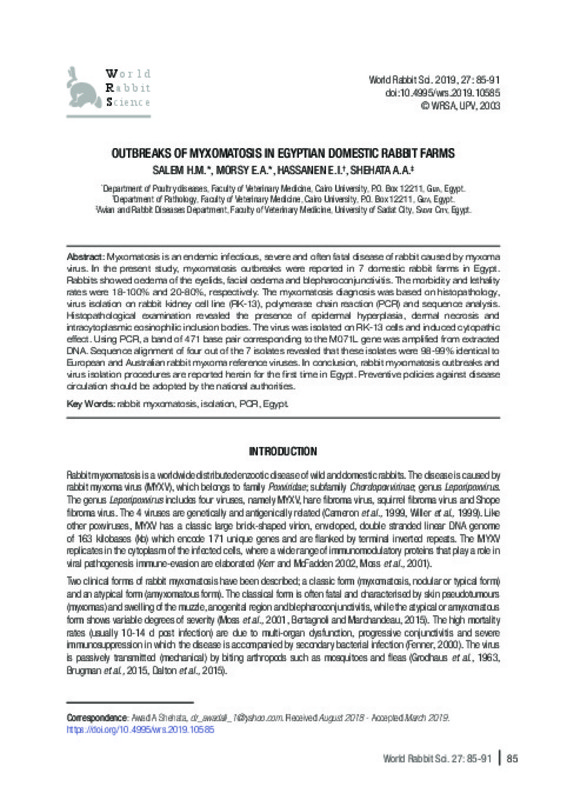Bertagnoli S., Marchandeau S. 2015. Myxomatosis. Rev. Sci. Tech., 34:549-556. https://doi.org/10.20506/rst.34.2.2378
Best S.M., Collins S.V., Kerr P.J. 2000. Coevolution of host and virus: cellular localization of virus in myxoma virus infection of resistant and susceptible European rabbits. Virology, 277: 76-91. https://doi.org/10.1006/viro.2000.0505
Brugman V.A., Hernández-Triana L.M., Prosser S.W., Weland.C., Westcott D.G., Fooks A.R., Johnson N. 2015. Molecular species identification, host preference and detection of myxoma virus in the Anopheles maculipennis complex (Diptera: Culicidae ) in southern England, UK. Parasit Vectors., 8: 421. https://doi.org/10.1186/s13071-015-1034-8
[+]
Bertagnoli S., Marchandeau S. 2015. Myxomatosis. Rev. Sci. Tech., 34:549-556. https://doi.org/10.20506/rst.34.2.2378
Best S.M., Collins S.V., Kerr P.J. 2000. Coevolution of host and virus: cellular localization of virus in myxoma virus infection of resistant and susceptible European rabbits. Virology, 277: 76-91. https://doi.org/10.1006/viro.2000.0505
Brugman V.A., Hernández-Triana L.M., Prosser S.W., Weland.C., Westcott D.G., Fooks A.R., Johnson N. 2015. Molecular species identification, host preference and detection of myxoma virus in the Anopheles maculipennis complex (Diptera: Culicidae ) in southern England, UK. Parasit Vectors., 8: 421. https://doi.org/10.1186/s13071-015-1034-8
Calvete C., Estrada R., Lucientes J., Osacar J., Villafuerte R. 2004. Effects of vaccination against viral haemorrhagic disease (VHD) and myxomatosis on long-term mortality rates of European wild rabbits. Vet. Rec., 155: 388-392. https://doi.org/10.1136/vr.155.13.388
Cameron C., Hota-Mitchell S., Chen L., Barrett J., Cao J.X., Macaulay C., Willer D., Evans D., McFadden G. 1999. The complete DNA sequence of myxoma virus. Virology, 264: 298-318. https://doi.org/10.1006/viro.1999.0001
Dalton K.P., Nicieza I., de Llano D., Gullón J., Inza M., Petralanda M., Arroita Z., Parra F. 2015. Vaccine breaks: Outbreaks of myxomatosis on Spanish commercial rabbit farms. Vet. Microbiol. 178: 208-216. https://doi.org/10.1016/j.vetmic.2015.05.008
Fenner F. 2000. Adventures with poxviruses of vertebrates. FEMS Microbiol. Rev., 24:123-133.
https://doi.org/10.1111/j.1574-6976.2000.tb00536.x
Ferreira, C., Ramírez, E., Castro, F., Ferreras, P., Alves, P.C., Redpath, S., Villafuerte, R. 2009. Field experimental vaccination campaigns against myxomatosis and their effectiveness in the wild. Vaccine, 27: 6998-7002.
https://doi.org/10.1016/j.vaccine.2009.09.075
Grodhaus G., Regnery D.C., Marshall I.D. 1963. Studies in the epidemiology of myxomatosis in California. II. The experimental transmission of myxomatosis between brush rabbits (Sylvilagus bachmani ) by several species of mosquitoes. Am. J. Hyg., 77: 205-212. https://doi.org/10.1093/oxfordjournals.aje.a120311
Kerr P., McFadden G. 2002. Immune responses to myxoma virus. Viral Immunol., 15: 229-246. https://doi.org/10.1089/08828240260066198
Kerr P.J. 2012. Myxomatosis in Australia and Europe: a model for emerging infectious diseases. Antiviral Res., 93: 387-415. https://doi.org/10.1016/j.antiviral.2012.01.009
Moss B. 2001. Poxviridae: The viruses and their replication. In: Fields B.N., Howley M.D., Griffin Ph.D., Lamb Ph.D., Martin M.D., Roizman B., Strauss M.D., Knipe Ph. D. (Eds.), Fields' virology, 4th ed., Lippincott Williams & Wilkins, Philadelphia. PA, USA. pp. 2849-2883.
OIE. 2107. Manual of Diagnostic tests and vaccines for terrestrial animals. Chapter 2.6.1. Myxomatosis(NB: Version adopted in May 2014).
Silvers L., Inglis B., Labudovic A., Janssens P.A., van Leeuwen B.H., Kerr P.J. 2006. Virulence and pathogenesis of the MSW and MSD strains of Californian myxoma virus in European rabbits with genetic resistance to myxomatosis compared to rabbits with no genetic resistance. Virology, 348: 72-83. https://doi.org/10.1016/j.virol.2005.12.007
Willer D.O., McFadden G., Evans D.H. 1999. The complete genome sequence of Shope (rabbit) fibroma virus. Virology, 264: 319-343. https://doi.org/10.1006/viro.1999.0002
[-]








